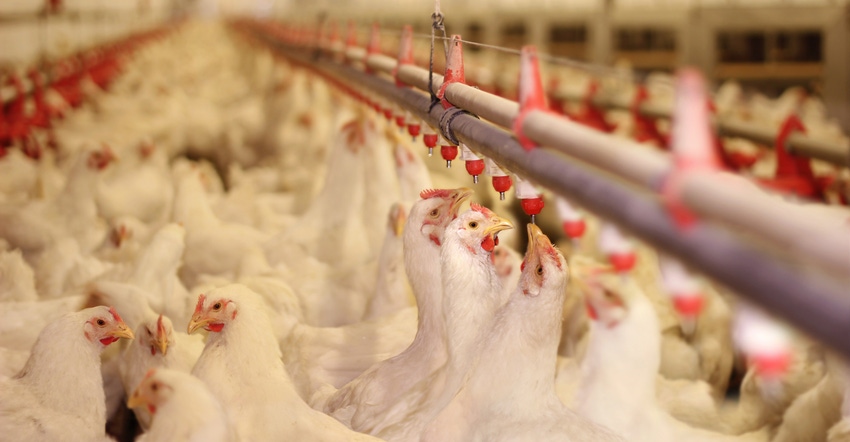
Highly pathogenic avian influenza is always a concern for poultry grower Georgie Cartanza, but Wednesday’s confirmation of an infection on a commercial farm in New Castle County, Del., is forcing her to take extra precautions.
“I’m holding my breath, and hoping and praying that we don’t have another farm break with it,” says Cartanza, who raises 148,000 organic broiler chickens in four houses in Dover, Del., and is an Extension poultry agent for University of Delaware Cooperative Extension. “As a poultry farmer, that’s like the worst thing that can happen.”
USDA confirmed the presence of highly pathogenic avian influenza (HPAI) — H5N1 — in a commercial poultry flock on Wednesday, the first commercial poultry case for Delaware since 2004. According to the Delaware Department of Agriculture, it is not known how the virus was contracted, but spokeswoman Stacey Hofmann says the farm in question reported increased mortality in birds the weekend of Feb. 19.
The USDA’s National Veterinary Services Laboratory in Ames, Iowa, confirmed poultry from the farm was positive for H5N1 avian influenza this week. Preliminary testing was performed at the University of Delaware’s Allen Laboratory in Newark, part of the National Animal Health Laboratory Network.
A 6-mile control zone around the farm has been set up, where farms are under quarantine and must get permitted to move poultry or eggs for processing. An additional 6-mile surveillance zone around the control zone has also been set up where a certain number of flocks are being tested to determine if there is spread.
The department says 1.2 million birds will be depopulated.
Michael Scuse, Delaware secretary of agriculture, said in a press release that all poultry flock owners should follow the strictest biosecurity, including:
limiting, monitoring and recording any movement of people, vehicles or animals on and off the farm
permitting only essential workers and vehicles to enter the farm to limit the chances of bringing the virus from an outside source
avoiding visiting other poultry farms and any unnecessary travel off the farm
disinfecting equipment, vehicles, footwear and other items that come into contact with flocks
keeping flocks away from wild or migratory birds, especially waterfowl
isolating any ill animals and contacting your veterinarian
In 2004, thousands of chickens were depopulated to prevent avian flu’s spread on Delmarva. That pales in comparison to the more than 40 million birds that were culled in 2015 because of the H5N2 flu in the Midwest, but a widespread outbreak of avian flu on Delmarva commercial flocks could have a huge impact on the $3.4 billion poultry industry in the region.
That’s why Cartanza is taking no chances. She’s tightened up biosecurity in several ways, including having dedicated footwear for each house; additional foot baths for people going in and out of the houses; and keeping houses closed after broilers are picked up for processing.
It’s all about taking biosecurity from the farm level to the house level, she says, because nothing can control an infected wild bird from defecating near a house and then someone unintentionally stepping on it and spreading disease.
“And so I think that the dedicated footwear to an individual house, that doesn't leave that house, is even a greater priority," Cartanza says.
Cartanza has even bought bird deterrents the size of beach balls with what appear to be eyes on them. She’s hanging them on the doors where chicken catchers normally come in and gather chickens for processing. She hopes the deterrents will scare starlings and other wild birds from entering a house.
“It really just speaks to how important biosecurity is,” she says. “I think human nature is people tend to get a little lax about things.”
Flu is spreading
Along with the New Castle case, HPAI has been detected on commercial turkey operations in Indiana and Kentucky, a commercial broiler operation in Kentucky, and in backyard chickens on Long Island and mixed species birds in Knox County, Maine.
There have been 247 detections of HPAI in wild birds, according to USDA’s Animal and Plant Health Inspection Service (APHIS). Five of these detections were in Kent County, Del., in wild birds on Feb. 16.
The first official detection of HPAI was on Jan. 13 in a hunter-harvested blue-winged teal in South Carolina. Since then, detections have spread rapidly up and down the East Coast, including the mid-Atlantic and New England. The Atlantic Flyway, a major north-south flyway for migratory birds in North America, passes over the region.
Cartanza says the University of Delaware and University of Maryland have sent out letters asking poultry growers to take additional biosecurity precautions.
Signs and symptoms of HPAI in birds include sudden death; lack of energy and appetite; nasal discharge, coughing or sneezing; incoordination; and diarrhea.
Keeping houses secure
The age of a poultry house makes no difference when it comes to making sure a house is secure from the introduction of an infectious disease.
“Even if you have a house that's 50 years old, if your bird wires are intact and you're not allowing any wild animals in and out of your house, it's really all about biosecurity," Cartanza says. “So that means you don't have a rodent problem, you're making sure you're properly composting and disposing of your dead birds properly. So, really, the age of the house does not determine your exposure in terms of avian influenza. As long as it’s an old house, and you don't have open doors and open cracks where wild birds are coming in.”
“From a disease perspective, it doesn't really matter,” she adds. “This is something that's going to enter a house most likely through shoe wear or on the hands.”
USDA-APHIS has several resources for growers with questions about HPAI:
Departments of agriculture in Maryland, Delaware and Pennsylvania also have producer resources for increasing biosecurity and reporting a case.
About the Author(s)
You May Also Like






